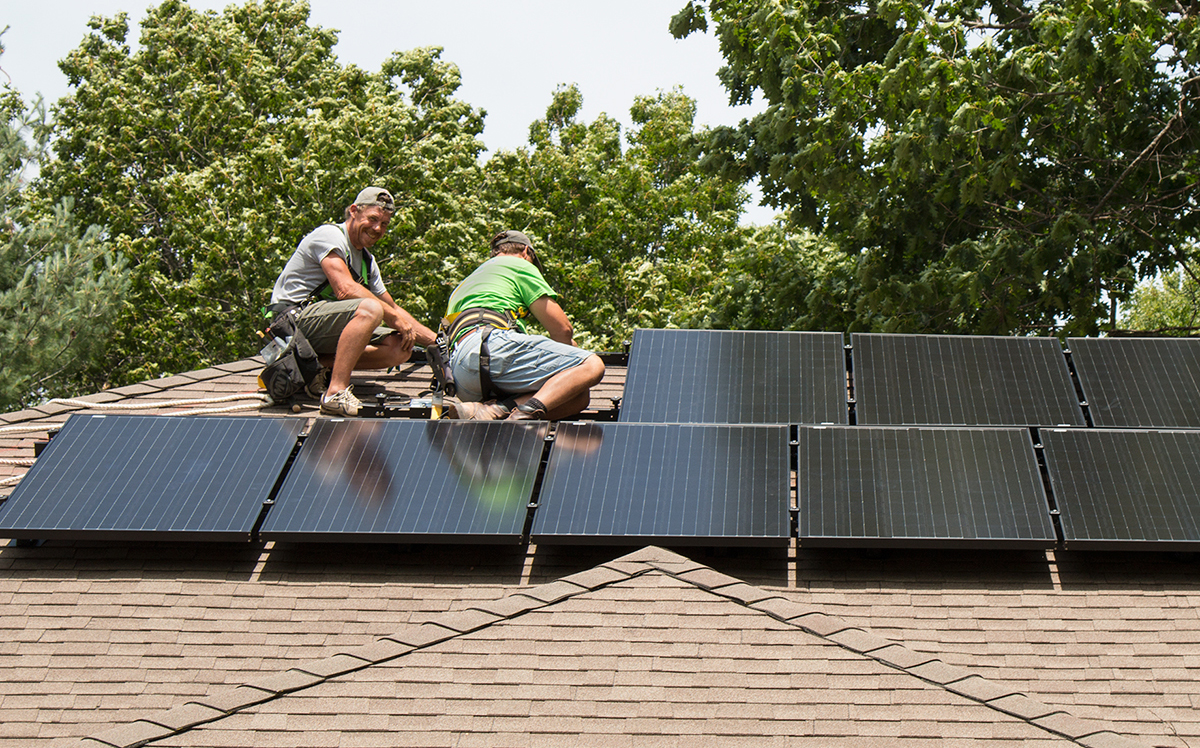Mott-funded programs help Michigan harness the power of rooftop solar

When Tim Dyste and his wife took a bike trip across Austria in 2015, they went to the Alpine nation as tourists. They returned as clean energy converts.
A year later, the retired Dow Corning manager invested in a $23,000 rooftop solar power system for his Midland home. A federal tax credit reduced the cost of the system to $16,000.
Dyste said he made the investment after seeing numerous solar systems in Austria — which has a climate similar to Michigan’s — and hearing a friend in Michigan who had rooftop solar boast about watching his electric meter run backwards.
“I had a casual interest in solar power for quite a while,” Dyste said. “I thought solar would make sense if I lived in Arizona, but wouldn’t be practical in Michigan due to our climate.”
He now knows better. Dyste said the 30 solar panels on his roof generated more electricity than he used in August and, over the course of a year, would provide about 70% of all the electricity his family uses at home.
“It’s a good investment, and I like the fact that it allows me to reduce my carbon footprint,” Dyste said.

Such comments are music to the ears of Stephen Wooden, a program manager at the Lansing-based Institute for Energy Innovation, a grantee of the Charles Stewart Mott Foundation. The institute is managing the first Solarize Michigan campaign, which aims to increase the use of rooftop solar on homes and small commercial buildings through community outreach, competitive contractor selection and bulk purchasing.
“There is a false perception that solar power doesn’t work well here,” Wooden said. “Michigan has more than enough sunlight to power solar systems, even during much of the winter.”
Michigan gets more sunlight on average than Germany — which ranks second globally in solar power deployment — but Germany has 5,000 times more solar power installed, according to data compiled by the U.S. and German governments.
Wooden said there are a number of reasons to invest in solar power:
- Michigan’s residential electricity rates are the highest in the Midwest and 20% higher than the national average, according to government data.
- The cost of solar power is going down, while the price of electricity from coal is increasing.
- The savings from cheaper monthly electric bills will pay for a typical residential rooftop solar system within 10 years.
- A typical residential system will generate free electricity for at least a decade after the solar panels are paid off.
- Congress recently extended a federal tax break for solar power investments until 2022.
- Solar power helps combat climate change.
Earlier this year, the Institute for Energy Innovation launched the Solarize Michigan campaign in three communities in the Great Lakes Bay Region of Michigan, which includes Bay, Isabella, Midland and Saginaw counties. The Groundwork Center for Resilient Communities, also a Mott grantee, recently launched a similar program in Traverse City and surrounding areas.
Both programs are designed to increase the use of rooftop solar and create models that could be used in other communities across Michigan. They help people figure out how to switch to solar at the lowest possible cost — by providing educational resources, connecting consumers to qualified contractors, purchasing solar systems in bulk quantities and passing along the savings.
Wooden said pricing challenges from electric utilities and potential changes to Michigan’s net metering law — which regulates how owners of solar systems sell excess energy to utilities — are hurting efforts to increase the use of rooftop solar.
Dan Worth, clean energy policy specialist at Groundwork, said his group is working with utilities in the area to create rate structures that accommodate greater use of solar power.
“Solar can be such a benefit to a community,” Worth said. “It’s about finding ways to make it work for everyone involved.”
Contractors with the rooftop solar campaign in the Traverse City area, called Groundwork Shines, began installing the first of 10 residential solar systems in late August. Worth said the goal is to place solar systems on 250 homes and small businesses in northwest Lower Michigan by the end of 2017.
The Institute for Energy Innovation hopes to equip at least 22 homes and small businesses in Michigan’s Great Lakes Bay Region with rooftop solar systems by the end of 2016, doubling the number of existing solar users in the region. Ten systems were installed as of Aug. 1, and 130 residents have signed up to become participants.
There is a false perception that solar power doesn’t work well here. Michigan has more than enough sunlight to power solar systems, even during much of the winter.”Stephen Wooden, Institute for Energy Innovation
“The installations got off to a slower than expected start, but the project has already succeeded in building community support for solar power and driving down installation costs,” Wooden said.
Michigan has a robust solar power supply chain, but the state accounts for just two-tenths of 1% of national solar deployment. Mott’s grantmaking supports nonprofit organizations that help homeowners, businesses and government institutions navigate the technical and financial aspects of switching to solar power.
“Investing in solar power is good for Michigan’s economy and the environment,” said Sam Passmore, director of the Mott Foundation’s Environment Program. “By supporting programs that make rooftop solar more accessible, we hope to accelerate the spread of clean energy across Michigan.”
Solar power is beginning to take hold in Michigan. A number of universities and businesses recently installed solar systems, and utilities are building large solar arrays in several cities, including Lapeer, Ann Arbor and Lansing.
Dyste said one of the most rewarding aspects of rooftop solar is that it gives him a large measure of control over his electricity costs. Like his friend who demonstrated that solar power is practical in Michigan, Dyste said, “It’s really fun to watch the meter run backwards.”
